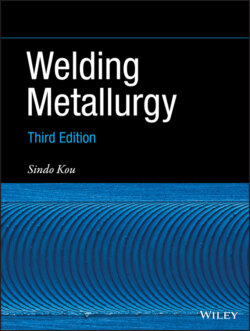Читать книгу Welding Metallurgy - Sindo Kou - Страница 98
3.4.4 Computer Simulation of Fluid Flow and Weld Penetration
ОглавлениеMishra et al. [45] showed that for a 304 stainless steel with 0.003 wt% (30 ppm) sulfur, ∂γ/∂T < 0 for the entire temperature range, and the outward surface flow transferred heat to the pool edge, thus resulting in a shallow weld. At 0.024 wt% (240 ppm) sulfur ∂γ/∂T > 0 up to about 2100 K (Fig. 3.18). The surface flow became inward and turned downward near the center of the pool surface to the pool bottom, carrying heat downward to the bottom and thus resulting in a deeper weld.
It is interesting to note that fluid flow in the weld pool can affect the shape of the pool surface. To demonstrate this, Tsai and Kou [43] used a body‐fitted coordinate system that fit the deformable pool surface of unknown shape. The coordinate system was reconstructed after each iteration of calculations of the temperature field, velocity field and pool shape. A body‐fitted coordinate system allows boundary conditions at the curved weld pool surface to be described accurately, including velocity, temperature and surface‐tension gradients.
Figure 3.23 shows the effect of dγ/dT alone on the weld pool [43], other driving forces for flow have been excluded. (Here, ∂γ/∂T is taken as dγ/dT assuming temperature T is the only variable affecting γ.) For the purpose of illustration, it shows the steady‐state velocity and temperature fields in stationary weld pools caused by heating a workpiece of 6061 Al alloy (~Al‐1Mg‐0.6Si) with a laser beam of 1800 W power and 8 mm diameter at its top surface. With dγ/dT < 0 the warmer lower‐γ liquid at the center of the pool surface is pulled outward by the cooler higher‐γ liquid at the pool edge. This outward surface flow carries the laser heat to the pool edge instead of the pool bottom, thus resulting in a shallow pool. With dγ/dT > 0 the opposite is true. The liquid at the pool surface flows inward toward the center, turns axially downward and carries heat to the pool bottom, thus resulting in a deeper pool. These results are consistent with Heiple's theory [27].
Figure 3.23 Computer modeling showing effect of dγ/dT on fluid flow in weld pool and shape of pool surface: (a) dγ/dT < 0 resulting in a concave pool surface; (b) dγ/dT > 0 resulting in a convex pool surface.
Source: Tsai and Kou [43]. © Wiley.
The effect of dγ/dT on pool‐surface deformation is interesting. With dγ/dT < 0 the fast outward surface flow (~1 m/s) is suddenly decelerated near the pool edge. Bernoulli's principle [21], though not used in the computer modeling, can be applied here as a simple explanation for the pool‐surface shape. The deceleration, according to the principle, causes the liquid pressure to rise and push the pool surface upward near the edge, resulting in a concave pool surface. Likewise, with dγ/dT > 0 the fast inward flow is suddenly decelerated near the pool center. The pool surface is raised by the pressure increase near the center and becomes convex.
Figure 3.24 shows the current‐density distribution in a stationary Al weld pool, the Lorentz force it induces, and the flow pattern the force creates [46]. The electric current converges from the workpiece to the center of the pool surface. The Lorentz force is inward and downward, thus pushing the liquid downward along the pool axis. This causes the liquid metal to fall along the pool axis and rises along the pool boundary. The maximum velocity is about 40 cm/s, much slower than Marangoni flow. The downward axial flow carries heat from the heat source to the pool bottom and causes a deep penetration.
Figure 3.24 Computer modeling showing flow driven by Lorentz force: (a) current density field; (b) Lorentz force field; (c) flow field.
Source: Tsai and Kou [46]. Welding Journal, June 1990, © American Welding Society.
Since liquid has a lower density than solid, e.g. by about 6% for aluminum [47]. The weld pool should expand as it forms, and this results in a convex pool surface. Figure 3.25 shows weld pool surface deformation caused by volume expansion due to melting (and superheating) [48]. The pool surface is convex because of the volume expansion. The flow induced by gravity, i.e. buoyancy flow, is too slow (about 1 cm/s) to cause surface deformation. Furthermore, the convexity is much more significant than that induced by Marangoni flow driven by dγ/dT < 0. This convex pool surface is very stable. Because it is supported by extra volume of liquid instead of by fast fluid flow. The concave pool surface under dγ/dT < 0 (Figure 3.23a) and convex pool surface under dγ/dT > 0 (Figure 3.23b) can be highly unstable because they are supported only by the surface tension effect under fast Marangoni flow.
Figure 3.25 Computer modeling showing significant weld pool surface deformation caused by volume expansion due to melting (and superheating): (a) convex pool surface; (b) slow fluid flow induced by buoyancy force.
Source: Tsai and Kou [48]. © Taylor and Francis.
Choo and Szekely [49] first considered turbulence in GTA weld pools and showed that turbulence can affect the pool depth significantly. Weckman and coworkers [50–52] demonstrated that a fluid flow model based on laminar can overpredict the pool depth, as shown in Figure 3.26 for a GTA weld in a 304 stainless steel. When turbulence is considered, however, the effective viscosity increases (μeff > μ) and convection slows down. Furthermore, the effective thermal conductivity (keff > k) increases and the effect of convection on the pool shape thus decreases. Consequently, the calculated pool depth decreases and agrees better with the observed one.
Figure 3.26 Weld pool shapes and isotherms in a 304 stainless steel with 50 ppm sulfur calculated based on: (a) laminar flow; (b) turbulent flow.
Source: Weckman [50–52]. © Taylor and Francis.
